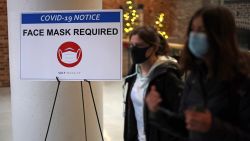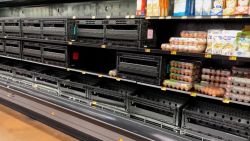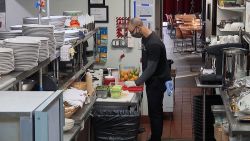Restaurants are starting to open their doors again as states ease pandemic-related regulations.
But it’s far from business as usual.
In addition to following new social distancing and hygiene rules, restaurants have to figure out how to get customers in the door. Understanding what consumers are looking for right now will help.
Enter Tanya Spaulding, principal at Shea Inc., a full-service restaurant design firm based in Minneapolis, Minnesota. She shared her tips with CNN Business on what will bring customers back in the pandemic era. Among the solutions: bright lights and clearing the clutter to make restaurants feel more open.
The following interview has been edited for clarity and brevity.
The importance of decluttering

CNN Business: Are there certain safety measures that [customers are] keeping an eye out for?
TS: All consumers are keeping an eye out for restaurants being responsible. So what we’ve been doing is working with a lot of our restaurant clients to do the basics — number one, just clean. I mean, literally clean everything. Remove clutter. Remove unnecessary décor. Remove things from your tabletop. That’s the first cue that consumers know that restaurateurs are taking this seriously.
When we design restaurants, we design a lot of interaction, a lot of layers of things, a lot of theater. Right now we’re counseling our restaurant clients to remove that, and the theater is really sanitation, disinfecting, cleanliness, respectful distance away from people.
CNN Business: Do you mean also get rid of salt and pepper and ketchup? What about those things, that people might be wary of touching?
TS: Yes. Take everything off the table, literally everything. Don’t even put candles on for right now. Guests will feel so much more comfortable if they walk and sit at a clean table with nothing on it. If they need salt and pepper, if they need condiments, maybe go to individual servings. Maybe go to smaller portions, more individual sizes for all of those things. People don’t want to pick up something and use something that someone else may have.
The same goes for menus and wine lists. That’s a big point where people touch things. So we’re recommending to a lot of our restaurants, make your menu very user-friendly and available on someone’s cell phone. There are going to be people that are going to be more comfortable looking at the menu on their own individual device.
Secondly, print the menus, and then tell guests that they can either take it home with them or throw it away when they’re done with it. So, there is no reusing. There is no, “I’m collecting the menus. I’m wiping them down and giving them to the next group.”

CNN Business: What about flatware and plates?
TS: Silverware is tricky. Plastic disposable just doesn’t work. But now is the time to take a look at your silverware. If it looks worn or if it looks like it’s old…buy something cheap for now that you can throw away after a months’ worth of uses. But guests will be scrutinizing it, so you have to scrutinize.
When you’re bringing plates out, or when you’re bringing silverware out, have someone scrutinize it. Make sure it was cleaned in high heat. Make sure there’s nothing wrong with it. Make sure it looks clean, it looks new, it’s sanitized. Make sure it immediately goes in the dishwasher under high heat, and guests are seeing that.
CNN Business: How are they seeing that if they can’t peek into the kitchen? Is there a way to let them know?
TS: This is where employee training comes in. Explain to [customers], when you’re grabbing their food. Maybe it’s how you bus the table. Showing it very visually that all of this is going directly into a dishwasher. Maybe showing the stack of plates coming out of the dishwasher. And if you can’t show it, just make sure the guests know that this is what we’re doing. Just like, “Here’s 10 things that we are ensuring for your safety.”
Bar seating 2.0
CNN Business: What kind of other cues are you sending out to customers to make them not only feel safe, but also want to come in and choose that restaurant?
TS: Dining at bars, at the physical bar, has been so popular. But you’re sitting side by side with people. So, with restaurants that have smaller bars, what we’re counseling to do is take away the bar stools, and just make it a service bar. With those restaurants that have a much larger bar, we’re pushing two high top tables up against the bar, and we’re actually creating tables of two sitting with their side up to the bar. So they’re still at the bar, but you’re creating tables, and you’re creating enough distance between people.
The other big thing is restrooms. The first thing we’re doing is telling restaurateurs, if you’ve got any actual towels or linens, you need to remove those. We’re putting hardware on doors where you can either open the door with your foot, or open the door with your elbow.
In other cases, we’re actually putting employees at certain doorways to open the doors for people. Opening the front door for them, maybe opening the restroom door for them, as long as they can keep their distance. Giving consumers the opportunity to go touchless as much as possible, without having to redesign your entire restaurant. If you don’t have the ability to go touchless, both on the inside of the door and the outside of the door, have paper towels there, and have a place for [people] to throw that away. Every point that there might be potential contact with a door or with a surface, it’s important to have a lot of those paper towels and tissues available for guests.
We’re creating branded floor signage. Dots on the floor, that sort of guide if you’re standing and waiting. Like, “This is your six feet.” But we’re doing it with their brand on it, so we’re printing them with perhaps a logo, perhaps a pattern that’s part of their brand. Maybe there’s some fun icons or elements that’s part of their menu design. We’re taking the restaurant’s personality, and trying to inject some of that into some of these requirements.
We’re putting arrows on the floor, so people know you go in this way, you go out this way. And you can kind of control people coming up against each other by some simple, interesting floor graphics.
‘Light and bright and clean’
CNN Business: What about the other touches? Maybe a new coat of paint, or other visual cues that might make the restaurant feel different?
TS: What we were telling a month ago, even six weeks ago [was] don’t sit and wait. Even though it’s the end of March, even though it’s the beginning of April, don’t wait. Some normalcy will return, and you need to be prepared for it. So, we were telling them then, maintenance. A fresh coat of paint. Make sure that you don’t have any chairs with fabric on them that appears to be dirty or worn. Clean your floors. I mean, just really make this thing sparkle and shine, so when guests come back in, they’re seeing light and bright and clean and well-maintained. It can’t smell stale. It has to smell fresh. It has to smell clean. And paint and disinfecting products aren’t necessarily a negative right now. You really want it to sparkle.
Lighting is a big part of this, too. Restaurants, at night in particular, tend to get darker, and we recommend that normally. But right now maybe take those light levels up, so people can see around them, so they can see that it’s a clean environment. They can see and sort of manage their own experience. Just open it up as much as possible. And if restaurants haven’t done that, I’d say scramble and do it right now.
CNN Business: What about layout?
TS: Don’t just move the furniture off to the side. Actually physically remove it from the space.
With booths, those can be a little trickier. If you’ve got a line of four of them, maybe you just seat every other one. In some cases that’s where we are using Plexiglas, to put behind the booth back. It just gives another comfort level.
We’re putting in sanitation stations in a lot of places. Hand sanitizer for guests at the entrance, anywhere near any doorway, and then just having them visually throughout.
What we’re really recommending is don’t do anything so permanent, that costs so much money to either do or undo, because right now, restaurants need to be conserving their cash and not spending more money unnecessarily.
Outdoor seating and cocktail kits

CNN Business: What are your thoughts on outdoor seating?
TS: As much as possible. Outdoor seating is going to be a lot more comfortable for people right now. So, every restaurant client, maximize your outdoor seating. If that means going to your landlord, if that means petitioning the city for temporary restrictions to be lifted, use as much sidewalk space, and as much parking space, if you’ve got it, as you can. Another thing that no one really mentions is valets. That’s probably not going to come back for a while. So if you’ve got valet parking stalls, see if you can convert that into outdoor seating. You might have rain, so use tents.
CNN Business: Is there anything that you’d like to add?
TS: Restaurants have gotten really creative at creating additional revenue streams, doing takeout, doing take and bake, doing meal kits, cocktail kits. If the restaurateurs haven’t started that, they really should, because that will stick. Restaurants will be able to continue to use that, and should continue to use that, for many months to come. It gives an opportunity for those guests that aren’t comfortable coming back in to still patronize you and to still buy your food. Look at your menu and determine what you can do as a take and bake, as a takeout, or as a meal kit, and keep that line open.
Until we start hearing the word vaccine, there are going to be a number of people that are very fearful, and they won’t come back in. Give them an opportunity to still buy your food. Keeping those measures in place is going to be really critical over these next couple of months. Don’t just remove it because you think you’re back in business. Maybe ramp it up even more.



























